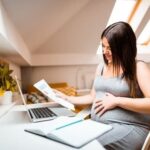When does pregnancy back pain start? For many expectant mothers, this question marks the beginning of a discomfort that can accompany them throughout their pregnancy journey. Understanding the causes of pregnancy back pain is essential in managing and preventing this common issue. From changes in hormone levels to the shifting center of gravity due to a growing belly, various factors contribute to the development of back pain during pregnancy.
The anatomy of the pregnant body undergoes significant changes to accommodate the growing fetus, affecting the back in particular. The increased curvature of the spine, stretched ligaments, and added weight can all put pressure on the back muscles and lead to discomfort. Additionally, hormonal changes during pregnancy can loosen joints and ligaments, further adding strain on the back. These physical changes can start as early as the first trimester and progress throughout pregnancy.
Exploring the early triggers of pregnancy back pain is crucial for expectant mothers to recognize and address any discomfort they may experience. While some women may start feeling back pain in the first trimester, others may not experience it until later stages of pregnancy.
Activities like standing for prolonged periods, lifting heavy objects incorrectly, or poor posture can exacerbate back pain during pregnancy. By understanding these triggers, pregnant women can take proactive steps to prevent or alleviate back pain before it becomes severe.
The Anatomy of the Pregnant Body
During pregnancy, the body undergoes numerous changes to accommodate the growing baby, leading to significant effects on the back. The increased weight of the uterus and fetus places added stress on the spine, pelvis, and supporting muscles. As a result, many expectant mothers experience an altered posture to adjust to this newfound weight distribution. The curvature of the lower back may increase (lordosis), causing strain on the muscles and ligaments in that region.
Additionally, hormonal changes during pregnancy can contribute to back pain. The hormone relaxin is produced in higher levels during pregnancy to loosen ligaments in preparation for childbirth. While this is crucial for the birthing process, it can also lead to instability in the joints of the pelvis and lower back, resulting in discomfort or pain. The combination of physical changes and hormonal influences can significantly impact how pregnancy affects the back.
Furthermore, as pregnancy progresses, the center of gravity shifts forward due to the growing belly. This forward shift can place additional strain on the lower back as it tries to support this new position effectively. The muscles along the spine must work harder to maintain balance and stability, often leading to fatigue and discomfort. Understanding these alterations in anatomy can help expectant mothers recognize how pregnancy impacts their backs and take proactive measures to manage any resulting pain or discomfort.
| Effects of Pregnancy on Back | Significance |
|---|---|
| Increased weight of uterus and fetus | Places stress on spine & muscles |
| Hormonal changes (e.g. relaxin) | Loosens ligaments, affecting joint stability |
| Forward shift in center of gravity | Strain on lower back & muscles |
When Does Pregnancy Back Pain Start
During pregnancy, many women experience back pain as their bodies go through significant changes to accommodate the growing fetus. But when does pregnancy back pain actually start? The truth is, it can vary from woman to woman, but generally, pregnancy back pain can begin as early as the first trimester. As the body starts to adjust to the added weight and shift in center of gravity, especially in the lower back, discomfort may start to manifest.
Understanding the early triggers of pregnancy back pain can help expectant mothers better prepare for and manage this common symptom. Here are some factors that may contribute to the onset of back pain during pregnancy:
- Increased levels of hormones such as relaxin, which relaxes ligaments and joints in preparation for childbirth
- Changes in posture due to shifts in weight distribution
- Growth of the uterus putting pressure on surrounding muscles and nerves
It’s essential for pregnant women to be aware of these early triggers so they can take proactive steps to prevent or alleviate back pain throughout their pregnancy. By practicing good posture, engaging in appropriate exercises, and seeking proper support when needed, expectant mothers can potentially minimize the impact of pregnancy-related back pain on their daily lives.
Common Symptoms of Pregnancy Back Pain
During pregnancy, many women experience back pain at some point. It is important to be able to recognize the signs of pregnancy back pain in order to address it effectively and seek appropriate treatment. One of the most common symptoms of pregnancy back pain is lower back discomfort or aching.
This can range from mild to severe and may be constant or intermittent. The weight gain associated with pregnancy can also put additional pressure on the spine, leading to discomfort in the lower back.
Another symptom of pregnancy-related back pain is pelvic pain or pressure. As the uterus expands during pregnancy, it can place strain on the muscles and ligaments supporting the pelvis, resulting in discomfort. This can cause difficulties with standing, walking, or even sitting for long periods of time. Additionally, some women may experience sciatic nerve pain during pregnancy. This type of pain is characterized by sharp shooting pains that radiate down one leg from the lower back.
In addition to physical symptoms, emotional changes such as stress and anxiety can also exacerbate pregnancy back pain. Hormonal changes during pregnancy can contribute to increased muscle tension and overall discomfort. It is important for expectant mothers experiencing back pain to be aware of these symptoms and seek appropriate care and management techniques to ensure a healthy and comfortable pregnancy journey.
Risk Factors for Developing Pregnancy Back Pain
During pregnancy, back pain is a common complaint among many expectant mothers. While the exact timing of when pregnancy back pain starts can vary from woman to woman, it typically begins to manifest in the second half of pregnancy as the baby grows and puts pressure on the spine and surrounding muscles. However, some women may experience back pain earlier on in their pregnancy due to various factors.
There are several risk factors that can increase the likelihood of developing pregnancy back pain. One major factor is weight gain, as the additional pounds put strain on the back and pelvis. Women who have had previous back issues or injuries are also at a higher risk for experiencing back pain during pregnancy.
Poor posture, especially as the belly grows larger, can exacerbate back pain symptoms. Additionally, women carrying twins or multiples may be more prone to experiencing back discomfort due to the added weight and stress on their bodies.
To help mitigate the risk of developing pregnancy-related back pain, there are steps that expectant mothers can take. These include maintaining a healthy weight through regular exercise (with doctor’s approval), practicing good posture while sitting and standing, wearing supportive footwear, and using proper body mechanics when lifting objects. It is also important for pregnant women to stay hydrated and incorporate stretching exercises into their daily routine to help keep muscles flexible and prevent tension in the back.
In addition to lifestyle changes, seeking guidance from healthcare providers such as doctors or physical therapists can be beneficial for managing and preventing pregnancy back pain. These professionals can offer personalized advice on exercises, stretches, and other interventions tailored to each individual’s needs. By staying proactive and informed about potential risk factors for pregnancy back pain, expectant mothers can better prepare themselves for a more comfortable and enjoyable pregnancy journey.
Managing Pregnancy Back Pain
During pregnancy, back pain is a common complaint among many expectant mothers. It can be caused by a variety of factors, including changes in posture, weight gain, hormonal changes, and the shifting of the body’s center of gravity. Understanding how to manage pregnancy back pain is essential for ensuring a comfortable and healthy pregnancy journey.
Maintaining Proper Posture
One of the keys to managing pregnancy back pain is maintaining proper posture. This involves sitting and standing up straight, avoiding slouching or leaning back excessively. Using supportive pillows when sitting or sleeping can also help alleviate pressure on the back and provide relief from discomfort.
Gentle Exercise
Engaging in gentle exercise routines designed specifically for pregnant women can help strengthen the muscles that support the back and improve flexibility. Activities such as prenatal yoga, swimming, or walking can be beneficial in reducing back pain and promoting overall well-being during pregnancy.
Using Proper Body Mechanics
When lifting objects or performing daily tasks, it is important to use proper body mechanics to prevent straining the back muscles. This includes bending at the knees when lifting heavy objects, avoiding twisting movements, and taking frequent breaks to rest and stretch. By being mindful of how you move your body, you can reduce the risk of exacerbating pregnancy-related back pain.
By incorporating these tips into your daily routine, you can effectively manage and prevent pregnancy back pain. However, if you experience persistent or severe back pain that interferes with your daily activities, it is important to consult with your healthcare provider for personalized recommendations and treatment options. Remember that prioritizing self-care during pregnancy is essential for maintaining your overall health and well-being.
Exercises for Pregnancy Back Pain
Experiencing back pain during pregnancy is a common phenomenon that many expectant mothers face. It can be discomforting and affect daily activities, but with the right exercises, it is possible to find relief and strengthen the back muscles for better support. So, when does pregnancy back pain start? Pregnancy back pain typically begins to surface around the second half of the pregnancy, as the baby grows larger and puts more strain on the spine and surrounding muscles.
One effective exercise for relieving pregnancy back pain is pelvic tilts. This exercise helps strengthen the abdominal muscles and improve posture, reducing strain on the lower back. To perform pelvic tilts, lie on your back with knees bent and feet flat on the floor. Slowly tilt your pelvis up towards your belly button while pressing your lower back into the floor. Hold for a few seconds before releasing. Repeat this movement several times to help alleviate back discomfort.
In addition to pelvic tilts, gentle stretching exercises can also provide relief from pregnancy back pain. Cat-cow stretches are particularly beneficial for stretching the spine and relieving tension in the lower back.
Get on your hands and knees, then gently arch your back towards the ceiling (like a cat) and hold for a few seconds before slowly arching your back in the opposite direction (like a cow). Repeat this movement several times to increase flexibility in the spine and reduce discomfort in the back region.
| Exercise | Description |
|---|---|
| Pelvic Tilts | Lie on your back with knees bent, tilt pelvis up towards belly button while pressing lower back into floor, hold for few seconds, repeat |
| Cat-Cow Stretches | Get on hands and knees, gently arch back towards ceiling (like a cat) then arch in opposite direction (like a cow), repeat several times |
Seeking Professional Help
During pregnancy, many women may experience back pain due to the changes their bodies undergo to accommodate the growing baby. It is important for expectant mothers to be aware of when pregnancy back pain commonly starts in order to seek appropriate support and care. Typically, pregnancy back pain can start as early as the first trimester, although it is more common in the second and third trimesters as the baby grows and places more strain on the back and pelvis.
As the uterus expands during pregnancy, it shifts the center of gravity forward, causing an increased curve in the lower back. This change in posture can lead to muscle tension and strain on the muscles supporting the spine, resulting in discomfort and pain. Additionally, hormonal changes during pregnancy can loosen ligaments and joints, further contributing to back pain. For some women, existing issues such as pre-existing back problems or poor posture can exacerbate pregnancy back pain.
If a pregnant woman experiences persistent or severe back pain that interferes with daily activities or worsens over time, it is essential to consult a healthcare provider. A doctor or physical therapist can help determine the underlying cause of the pain and provide appropriate treatment options.
They may recommend specific exercises, chiropractic care, massage therapy, or other interventions to alleviate discomfort and improve mobility. Seeking professional help early on can prevent long-term complications and promote a healthier pregnancy experience for both mother and baby.
Conclusion
In conclusion, it is crucial for expectant mothers to have a thorough understanding of pregnancy back pain in order to effectively manage and alleviate discomfort. By knowing the anatomy of the pregnant body and recognizing the early triggers of back pain, women can take proactive steps to prevent or reduce symptoms. Understanding common signs and risk factors can help individuals identify when pregnancy back pain may start and who is at higher risk.
Empowering expectant mothers with knowledge on pregnancy back pain not only enables them to better cope with any discomfort, but also promotes overall well-being during this special time. It is important for pregnant individuals to engage in exercises that strengthen and stretch their back muscles, as well as seek professional help when necessary. Whether consulting a doctor or physical therapist, seeking guidance from healthcare professionals can provide valuable insights and personalized strategies for managing pregnancy back pain effectively.
Ultimately, by staying informed and taking proactive measures to care for their bodies, expectant mothers can navigate the challenges of pregnancy back pain with confidence and ease. With the right tools and support system in place, women can prioritize their own health and well-being throughout each stage of pregnancy. Remember, knowledge is power when it comes to addressing pregnancy back pain – so stay informed, stay active, and don’t hesitate to seek help when needed.
Frequently Asked Questions
How Many Days Before Period Does Back Pain Start?
Back pain before a period can start anywhere from 2-7 days before menstruation begins. This is typically due to hormonal changes and muscle tension associated with menstrual cycles.
Which Side Do You Feel Pain in Early Pregnancy?
In early pregnancy, women may experience pain or cramping on either side of the abdomen due to the stretching of ligaments as the uterus expands. It is important to consult a healthcare provider if pain is severe or persistent.
When Does Pregnancy Start to Get Uncomfortable?
Pregnancy can start to become uncomfortable for many women during the second trimester, around weeks 18-24. This is when the uterus begins to grow significantly, causing symptoms like back pain, pelvic pressure, and increased frequency of urination.
As the baby grows further into the third trimester, discomfort may increase even more with symptoms like fatigue, swelling, and shortness of breath becoming more pronounced.

Welcome to my fertility blog. This is a space where I will be sharing my experiences as I navigate through the world of fertility treatments, as well as provide information and resources about fertility and pregnancy.





